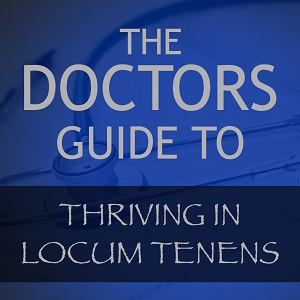(My wife and I will soon be enjoying our timeshare on a three week snow birding vacation in the Texas cities of San Antonio, Austin, and Galveston. If you live in or near any of these cities (Houston?) and would like to join us for a meet up, contact me, we’d love to meet you.
Today’s guest post comes from Naomi Olson, a certified Financial Planner in Omaha, Nebraska who is married to a physician. We have no financial relationship.)
Disability insurance provides financial protection for workers who can no longer work due to an injury or illness. The coverage helps replace a portion of income lost due to a disability that prevents the person from completing their job requirements.
Most disability policies replace up to 60% of lost income for a specific period of time. The policyholder pays a monthly premium for their disability insurance coverage and is eligible for benefits if they become disabled before their retirement age, as determined by the policy’s definition of disability. Having disability insurance is imperative for physicians, as they are more likely to become disabled than to die during their working years.
Unfortunately, some insurance policies charge a ‘pink tax’, which is a 40-50% higher rate on insurance premiums for women. This is because women physicians are more likely to encounter disabilities than their male counterparts.
Moreover, it is even more important for women in the medical field to acquire disability insurance, as 55.6% of females in the profession fall under the age of 45. This means they are at a greater likelihood of missing out on decades of earning potential in the unfortunate case of becoming disabled.
It is important to understand any exclusions or limitations on your company’s disability policy to ensure you get good benefits. You must also consider the disability insurance elimination period, which is the amount of time that a policyholder must wait before they can start receiving disability benefits.
Considerations in Employer-Sponsored or Group Long-Term Disability Policies
Employer-sponsored policies vary by company and may cover lost wages for a specific period of time or provide partial coverage for employers who want to supplement their existing insurance plans.
For female physicians, the policy may also cover the loss of income related to pregnancy, for example, if the employee requires bed rest before or after giving birth.
Employers often provide Long-Term Disability (LTD) insurance coverage with the employment contract. It is important to read through the policy criteria to ensure the plan is suitable for your needs.
For example, your group LTD plan may cover a specific percentage of your income with a pre-determined monthly “cap.” So, if the cap amount is $15,000, and your monthly benefit is calculated at 50% of your salary (which is $50,000 a month), you will only receive coverage of $15,000 a month. This means the remaining amount of your income will be left uninsured. Considering this, you may need additional coverage.
Keep in mind that group LTD insurance plans often do not cover anything beyond your salary base, such as overtime pay, shift pay, bonuses, or any additional incentives.
Don’t forget to take taxation into account. If the employer pays the premium for your group LTD policy without adding it back to your taxable income, you will be required to pay taxes on the benefits. This will further cut down the total amount of benefits earned via the coverage.
Moreover, the group plans may also subtract the benefit amount you receive from Social Security Disability, Worker’s Compensation, and other income sources classified as ‘deductible.’
Group LTD policies often fail to provide an “own-occupation” definition of disability. So, if you are still capable of working in any form, even at a lower-paying capacity, such as a surgeon who could no longer operate, but could still see patients in the office, you will not be able to collect benefits. Therefore, choosing a policy that includes an “own-occupation” clause is imperative.
Lastly, you can also leverage the “multi-life” discount, which may be offered to three or more physicians working at the same practice. Using this approach can save you around 50% in insurance premium payments. Moreover, you can opt for a longer waiting period before accessing the benefits to further cut down premium costs. You can also reduce the premium by signing up for the policy at an earlier age and making healthier life choices (such avoiding smoking).
Loopholes in the Own-Occupation Clause in Physician’s Disability Insurance
Limitations in the Clause: Some insurance policies may advertise their offerings as “Own-occupation,” but the defined conditions may limit your benefits. For instance, if the plan states, “Each and every material duty of your specific occupation,” it implies that you’ll only receive rewards if you’re entirely unable to work.
Early-Expiration Date: It is also possible for your insurance plan to start out as an “own occupation” but transform into “any occupation” after a specific period of time. Therefore, it is essential to check the time duration for own-occupation coverage.
Partial Disability Coverage: Female doctors are more likely to experience restrictive conditions, such as arthritis and back pain, especially after giving birth. In such cases, they may not be able to carry out their responsibilities as frequently as before. Since these conditions can be classified as partial disabilities, you can claim benefits through your own-occupation policy. Physicians with income declines below 85% of their regular earning can claim benefits only if they have a partial disability clause.
Special Considerations for Females
Female physicians are more likely to suffer from a disability than their male counterparts due to factors such as pregnancy, childbirth, and other medical issues.
A disability can have major implications for your ability to continue working in medicine and providing for yourself and your family.
When evaluating your disability coverage, there are several key aspects that you should consider:
– What types of disabilities does the policy cover? Make sure it covers both physical and mental health conditions related to your job.
– How long does the coverage last? This is important to ensure that you will be protected if you cannot work for an extended period due to your disability.
– What percentage of salary will be provided during the disability period?
– Are there any exclusions in what the policy does not cover? Be sure to find out if any pre-existing conditions or illnesses could lead to a denial of coverage.
Consideration in the Disability Insurance Elimination Period
The disability insurance elimination period starts from the day you experience disability. It continues throughout the duration mentioned in the policy. During this period, the policyholder will not receive any disability payments for their lost wages. The elimination period typically lasts anywhere from 60 days to several months, but it can vary depending on the terms of an individual’s disability policy.
The elimination period plays a role in determining your monthly payment rate. You will be charged less if you opt for a plan with a longer waiting period. However, this decision must be made carefully, and should take into consideration how much you have set aside in savings/emergency fund. If your elimination period is six months, do you have six months’ living expenses saved to get you through this waiting period before you benefits kick in?
An important factor in selecting a disability insurance policy is understanding what type of elimination period to choose. You can select between calendar days and consecutive days. Calendar day eliminates based on total days, regardless of whether the disability has been continuous or not. Consecutive day eliminates based on consecutive days the policyholder cannot work due to a disability. This type of elimination period may provide more protection for policyholders who experience intermittent disabilities because you only have to wait for those consecutive days before benefits begin.
Wrapping Up
A disability insurance policy can provide important peace of mind by ensuring your income and savings are protected in the event of a disability. By ensuring you have adequate coverage, you can rest assured knowing your finances will remain secure. However, it is essential to comprehensively read and understand the policy criteria to certify maximum and appropriate benefits for your individual needs.





